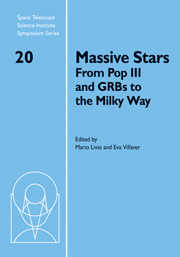Book contents
- Frontmatter
- Contents
- Participants
- Preface
- High-mass star formation by gravitational collapse of massive cores
- Observations of massive-star formation
- Massive-star formation in the Galactic center
- An x-ray tour of massive-star-forming regions with Chandra
- Massive stars: Feedback effects in the local universe
- The initial mass function in clusters
- Massive stars and star clusters in the Antennae galaxies
- On the binarity of Eta Carinae
- Parameters and winds of hot massive stars
- Unraveling the Galaxy to find the first stars
- Optically observable zero-age main-sequence O stars
- Metallicity-dependent Wolf-Rayet winds
- Eruptive mass loss in very massive stars and Population III stars
- From progenitor to afterlife
- Pair-production supernovae: Theory and observation
- Cosmic infrared background and Population III: An overview
Optically observable zero-age main-sequence O stars
Published online by Cambridge University Press: 04 August 2010
- Frontmatter
- Contents
- Participants
- Preface
- High-mass star formation by gravitational collapse of massive cores
- Observations of massive-star formation
- Massive-star formation in the Galactic center
- An x-ray tour of massive-star-forming regions with Chandra
- Massive stars: Feedback effects in the local universe
- The initial mass function in clusters
- Massive stars and star clusters in the Antennae galaxies
- On the binarity of Eta Carinae
- Parameters and winds of hot massive stars
- Unraveling the Galaxy to find the first stars
- Optically observable zero-age main-sequence O stars
- Metallicity-dependent Wolf-Rayet winds
- Eruptive mass loss in very massive stars and Population III stars
- From progenitor to afterlife
- Pair-production supernovae: Theory and observation
- Cosmic infrared background and Population III: An overview
Summary
A list of 50 optically observable O stars that are likely on or very near the ZAMS is presented. They have been selected on the basis of five distinct criteria, although some of them exhibit more than one. Three of the criteria are spectroscopic (He II λ4686 absorption stronger than in normal luminosity class V spectra, abnormally broad or strong Balmer lines, weak UV wind profiles for their spectral types), one is environmental (association with dense, dusty nebular knots), and one is photometric (derived absolute magnitudes fainter than class V). Very few of these stars have been physically analyzed, and they have not been considered in the current framework of early massive stellar evolution. In particular, they may indicate that the earliest, embedded phases are not as large a fraction of the main-sequence lifetimes as is currently believed. Detailed analyses of these objects will likely prove essential to a complete understanding of the early evolution of massive stars.
Introduction
It is often stated that zero-age main-sequence (ZAMS) O stars should not be and are not observed. This view arises from at least three sources: star-formation theory, which suggests that the embedded accretion (merger?) phases constitute a significant fraction of the main-sequence lifetimes of massive stars (2.5 Myr for the most massive); statistical studies of UCHII and IR objects relative to optically observed ones; and detailed physical analyses of optical O-star samples that find very few on the ZAMS.
- Type
- Chapter
- Information
- Massive StarsFrom Pop III and GRBs to the Milky Way, pp. 167 - 177Publisher: Cambridge University PressPrint publication year: 2009
- 13
- Cited by



